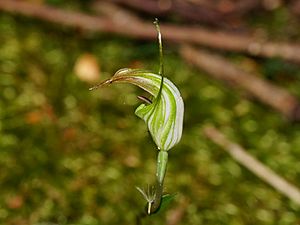Summer greenhood facts for kids
Quick facts for kids Summer greenhood |
|
|---|---|
 |
|
| Pterostylis decurva growing near the Meander River in Tasmania | |
| Scientific classification | |
| Genus: |
Pterostylis
|
| Species: |
decurva
|
| Synonyms | |
|
Diplodium decurvum (R.S.Rogers) D.L.Jones & M.A.Clem. |
|
The Summer Greenhood, or Pterostylis decurva, is a unique type of orchid that grows only in south-eastern Australia. This means it is endemic to that area. Like other greenhood orchids, this plant looks different depending on whether it is flowering or not. Plants that are not flowering have a group of leaves shaped like a rosette. But flowering plants have a single flower on a tall stem with leaves along the stem. This greenhood usually blooms in summer. Its flower is white with green stripes and a brownish tint. It looks a bit like another orchid, P. aestiva, but the Summer Greenhood has paler green flowers.
What Does It Look Like?
The Summer Greenhood is a plant that grows from the ground. It is a perennial plant, meaning it lives for more than two years. It is also deciduous, so its leaves fall off at certain times. This plant has an underground tuber, which is like a small storage root.
When the plant is not flowering, it has a rosette of two to five leaves. These leaves are often held above the ground on a stalk up to 100 mm (about 4 inches) long. Each leaf is shaped like an oblong or an egg. They are usually 10–30 mm long and 10–20 mm wide.
When the plant is flowering, it grows a single flower on a spike. This spike can be 150–300 mm (about 6 to 12 inches) tall. It also has four or five leaves along the stem. The flowers are white with green stripes. They also have a brown tint on the "galea," which is the hood-like part of the flower.
The top part of the flower, called the dorsal sepal, and the petals are joined together. They form a hood over the column, which is the central part of the orchid flower. This hood curves forward, sometimes even downwards. It has a thin, thread-like tip that is 15–20 mm long. The side sepals are held close to the hood. They have an upright, thread-like tip that is 30–40 mm long. There is a wide, U-shaped dip, or sinus, between their bases.
The "labellum" is another part of the flower. It is 12–15 mm long and 2.5 mm wide. It is brown, has a blunt end, and curves outwards, sticking out above the sinus. These beautiful flowers usually bloom from October to March.
How It Got Its Name
The Summer Greenhood, Pterostylis decurva, was first officially described in 1923. A scientist named Richard Sanders Rogers wrote about it. His description was published in a scientific paper called Transactions and Proceedings of the Royal Society of South Australia.
The second part of its scientific name, decurva, comes from a Latin word. It means "curved or bent downwards." This name likely refers to the way the flower's dorsal sepal curves.
Where Does It Grow?
The Summer Greenhood can be found in different parts of south-eastern Australia. It grows in the higher areas of the ranges and tablelands in Victoria. You can also find it in New South Wales, especially south from Werrikimbe National Park. In Tasmania, it sometimes grows at lower altitudes as well.

